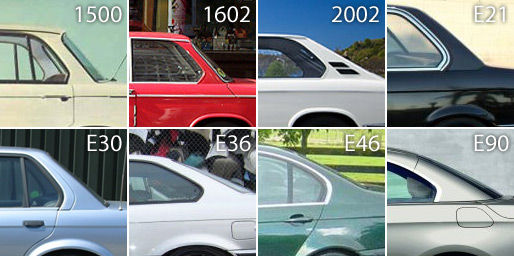Whats the BMW Hofmeister kink?
- Nils Willner

- Jul 13, 2022
- 2 min read
Updated: Aug 22, 2022
The Hoffmeister Kink (Hofmeister-Knick) is a prominent and unique BMW design feature which almost all the BMW models have in common. Just like the kidney grille, the Hofmeister kink is instantly associated with the brand. The kink is a visual design element that’s been featured on almost every model since the advent of the BMW Neue Klasse in 1961. Even other manufacturers have incorporated this design feature in their model lineup. It can easily be identified by the slight bent in the C-pillar and is named after Wilhelm Hofmeister, who was chief of design at BMW from 1955 - 1970.
The New Class coupes from 1962 - 1977 first saw the introduction of the Hofmeister kink, which has been used on most BMW cars since. It was first seen on the BMW 1500 and the 3200 CS, which premiered in 1961 at the Frankfurt Motor Show.

Wilhelm Hofmeister (1912–1978) was BMWs design chief from 1955 to 1970 and was credited with the design of the BMW New Class and the Hofmeister kink. Though, the kink appeared already on other car brands before Hofmeister's work at BMW.

This design element was featured already on some 1949-model 2-door cars made by General Motors, including the Cadillac Club Coupe, Buick Sedanette, and Chevrolet Fleetline, as well as the 1958 Lancia Flaminia Sport Zagato and the 1961 Lancia Flavia Coupé.

In early models, the widened base of the C-pillar sometimes featured the BMW roundel, for example, with the BMW E9 range or the 2000 C and CS models.

Apart from its stylistic effect, the Hofmeister kink is said by BMW to suggest that all its models have rear-wheel drive or all-wheel drive biased to the rear. Since the kink debuted in 1961, it appeared on almost all BMW models ever since.

Similar C-pillar kinks have appeared on cars of other brands both before 1961 and afterwards. For example, the 1951 Kaiser Deluxe Golden Dragon shows a considerable "Hofmeister kink". Later, it was found on the Volkswagen Golf Mk1 of 1974, the Series II Fiat 127 in 1977 and the 1994 Chevrolet Impala SS.


BMW always tried to reinvent itself and its design language which was often the case with the sizing of the kidney grilles. Today, they have grown out of proportion. Design trends change substantially over time. Similar experiments were made with the Hofmeister kink. For example, the 2021 BMW M4 with its oversized pig nose features an extremely low-slanted kink.

Another attempt at redesigning the kink was done on the E24 models which feature a very soft and round kink on the C-pillar.

Although, BWM didn't always incorporate the Hofmeister Kink and some of the brand's controversial models such as the BMW Z3 M Coupe and the BMW 5-Series E34 Touring don't show one at all.


Here are a few more BMW and Non-BMW cars that feature the kink:
Photos: wikipedia.org/wiki/Hofmeister_kink
Which car models do you know that feature the Hofmeister Kink? Comment below!

Nils Willner
Nils is a Swiss-German engineer who is obsessed with old cars and engines. He is the author of "The Ultimate Classic Car Guide - How to Buy, Maintain & Repair Classic Cars" and the founder of EVC. His passion has always been with old cars and everything that has wheels and an engine.




















Comments